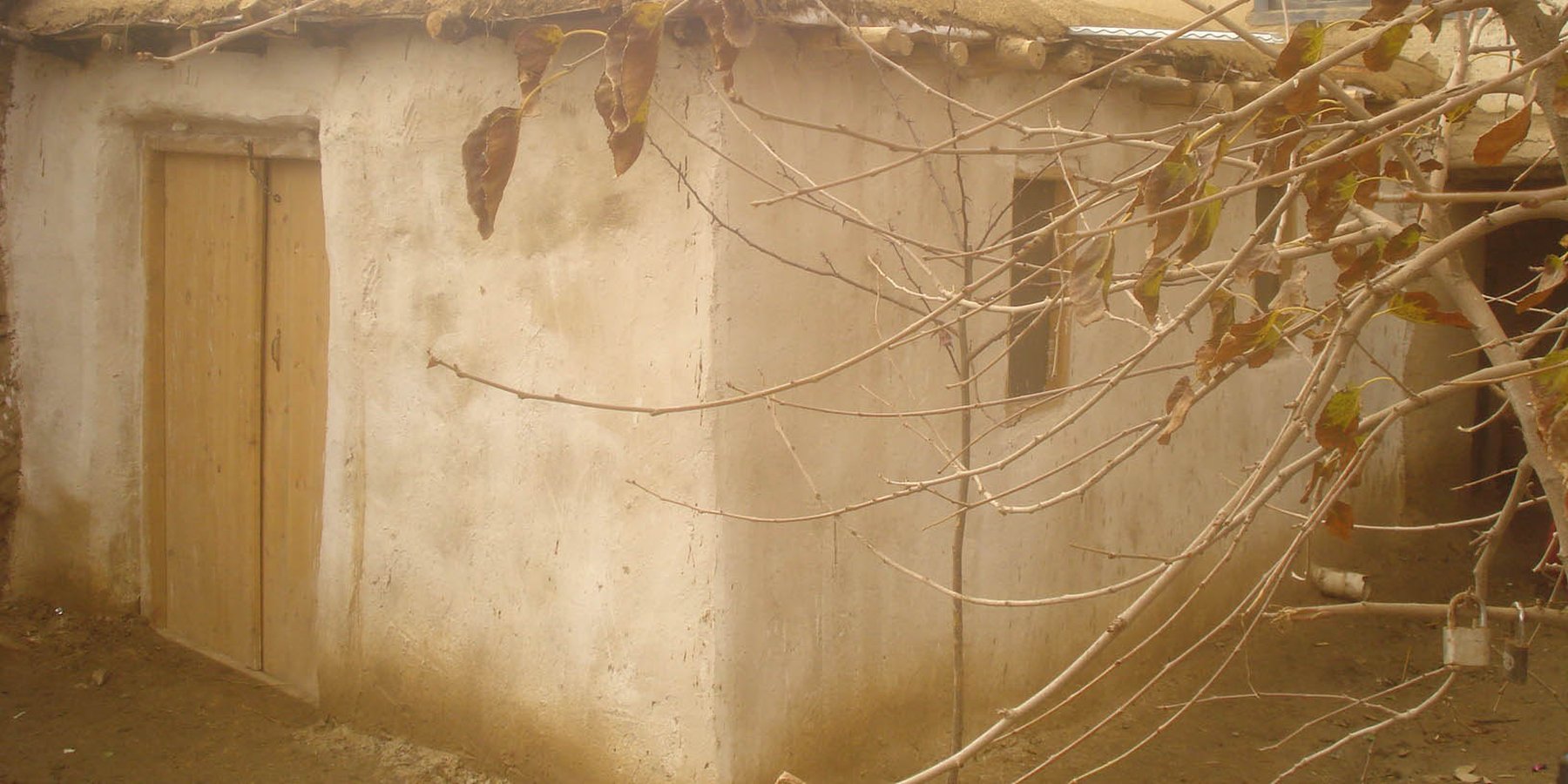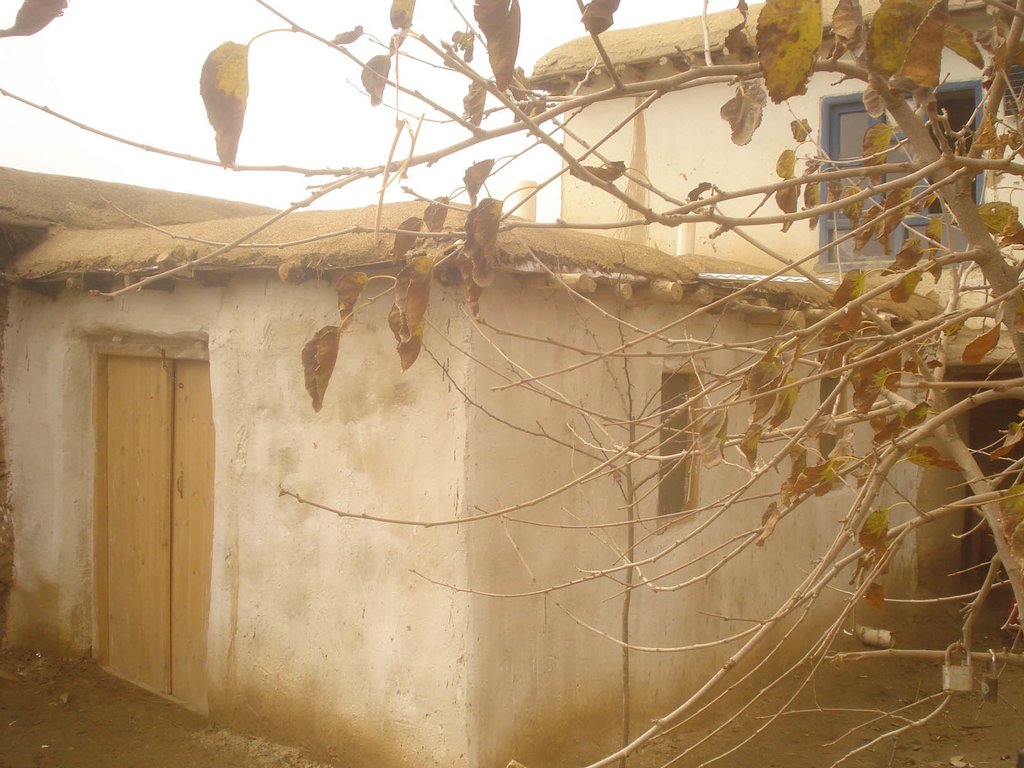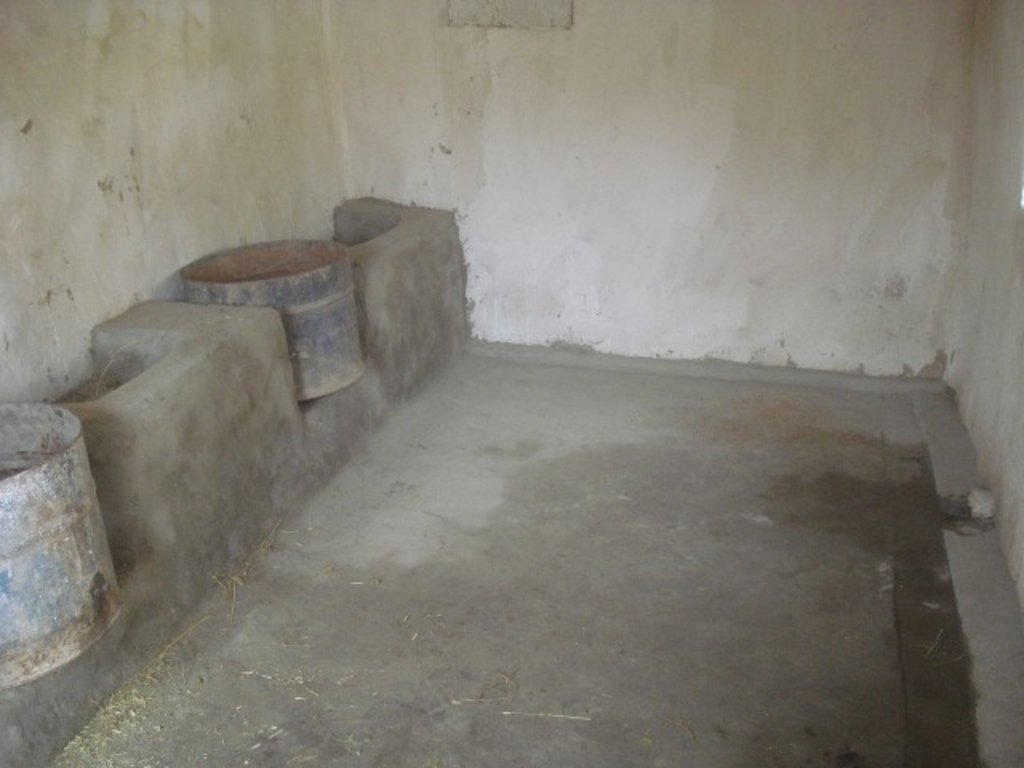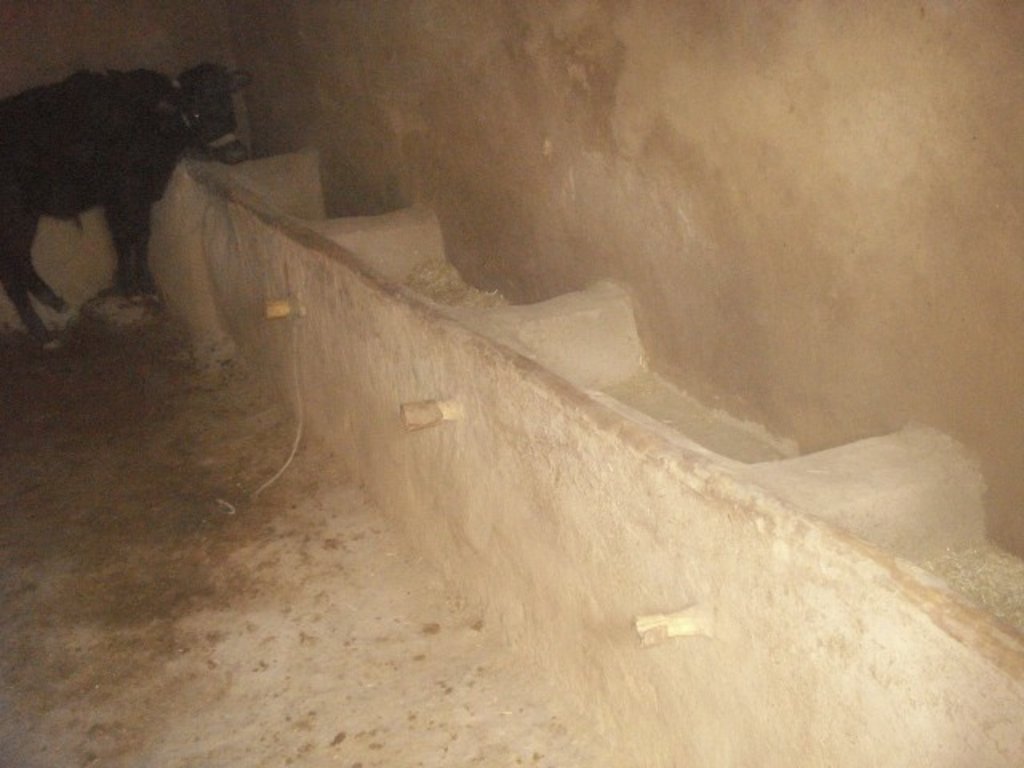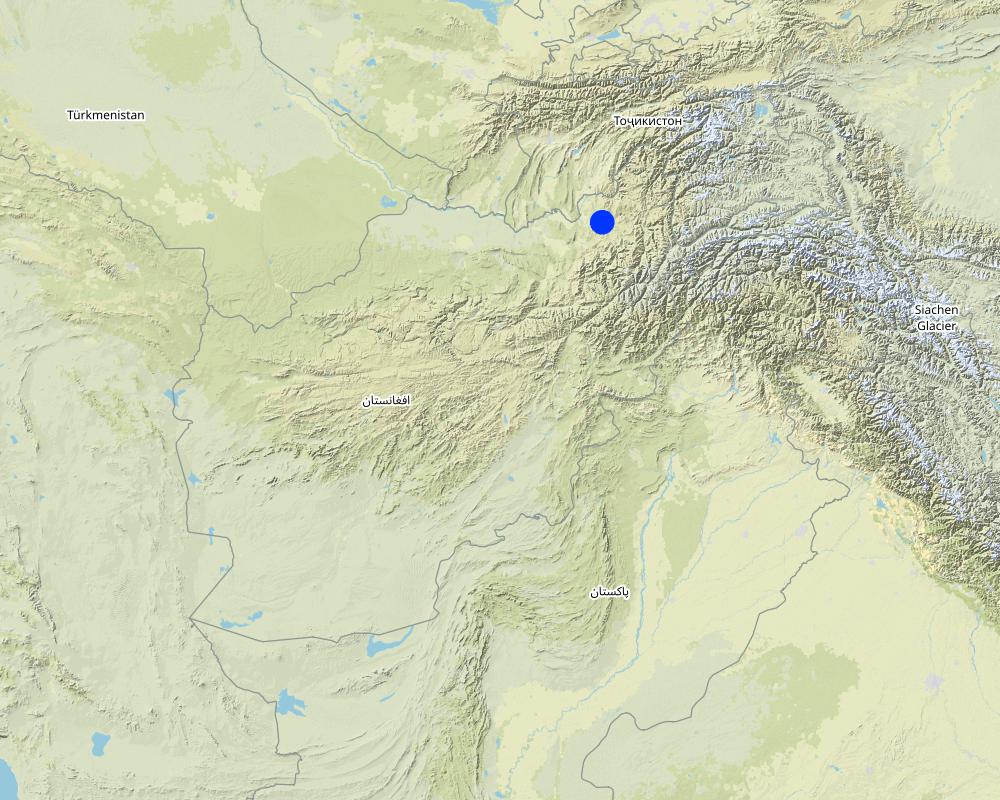Improved livestock shed for better health and productivity [Афганистан]
- Шинийг нээх:
- Шинэчлэх:
- Эмхэтгэгч: Bettina Wolfgramm
- Хянан тохиолдуулагчид: Miajan Maroofi, Hekmatullah Sharifzai, Roziya Kirgizbekova, Aslam Qadamov
- Хянагч: William Critchley
Tabela; Oghil
technologies_673 - Афганистан
Бүлгүүдийг үзэх
Бүгдийг дэлгэх Бүгдийг хаах1. Ерөнхий мэдээлэл
1.2 Технологийг үнэлэх, баримтжуулах ажилд хамаарах мэдээлэл өгсөн хүмүүс, байгууллагуудын холбоо барих мэдээлэл
Researcher:
Газар ашиглагч :
Alti Boy Sherogha
Natural Resources Management Committee (NRMC)
Sari Joy village, Rustaq District
Афганистан
Технологи баримтжуулах/үнэлэх ажилд дэмжлэг үзүүлсэн төслийн нэр (шаардлагатай бол)
Livelihood Improvement Project Takhar, Afghanistan (LIPT)Технологи баримтжуулах/үнэлэх ажилд дэмжлэг үзүүлсэн төслийн нэр (шаардлагатай бол)
Potential and limitations for improved natural resource management (NRM) in mountain communities in the Rustaq district, Afghanistan (Rustaq NRM Study)Технологи баримтжуулах/үнэлэх ажилд дэмжлэг үзүүлсэн байгууллага(ууд)-ын нэр (шаардлагатай бол)
Terre des Hommes (Terre des Hommes) - ШвейцарТехнологи баримтжуулах/үнэлэх ажилд дэмжлэг үзүүлсэн байгууллага(ууд)-ын нэр (шаардлагатай бол)
Swiss Agency for Development and Cooperation (DEZA / COSUDE / DDC / SDC) - ШвейцарТехнологи баримтжуулах/үнэлэх ажилд дэмжлэг үзүүлсэн байгууллага(ууд)-ын нэр (шаардлагатай бол)
CDE Centre for Development and Environment (CDE Centre for Development and Environment) - Швейцар1.3 ВОКАТ-аар баримтжуулсан өгөгдлийг ашиглахтай холбоотой нөхцөл
Эмхэтгэгч болон гол мэдээлэгч хүн(хүмүүс) WOCAT аргачлалаар баримтжуулсан мэдээллийг ашиглахтай холбоотой нөхцлийг хүлээн зөвшөөрсөн:
Тийм
1.4 Технологи тогтвортой гэдгийг баталгаажуулах
Энэ технологийг газрын доройтлыг бууруулж, газрын тогтвортой менежментийг хангахад тохиромжтой гэж үзэж болох уу?
Үгүй
Тайлбар:
SLM practices documented in the frame of the Rustaq NRM study were established only recently (1-3 years ago). It is too early for a final judgment on the sustainability of these technologies within the human and natural environment of Chokar watershed.
1.5 ГТМ-ийн Арга барилын талаархи санал асуулгын(д) суурь мэдээлэл
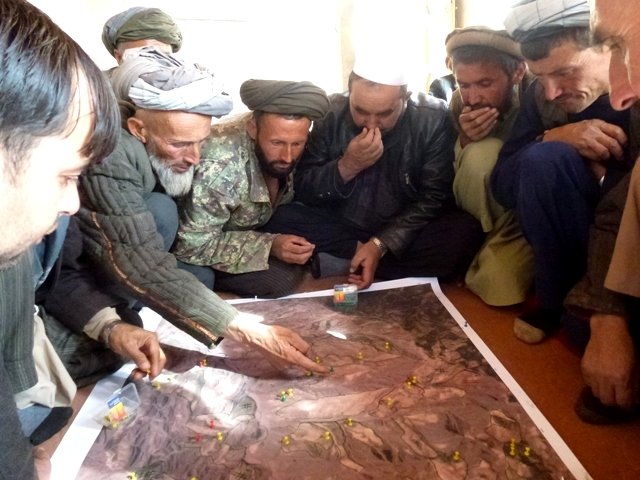
Watershed Associations (WSA) and Natural Resource Management Committees … [Афганистан]
Two Watershed Associations (WSA), in Chaker and Nahristan watershed areas respectively, are registered at the national level with the Ministry of Agriculture Irrigation and Livestock (MAIL) and at the regional level with the Department of Agriculture. Both associations are strong, active, dynamic, and have the capacity to coordinate and support …
- Эмхэтгэгч: Bettina Wolfgramm
2. ГТМ Технологийн тодорхойлолт
2.1 Технологийн товч тодорхойлолт
Технологийн тодорхойлолт:
Existing livestock sheds can be improved through interior and exterior refurbishing, and door and window installation. More favourable indoor conditions benefit animal health and the quality of animal products.
2.2 Технологийн дэлгэрэнгүй тодорхойлолт
Тодорхойлолт:
Livestock keeping is one of the key livelihood strategies in rural Rustaq - in addition to cultivation of agricultural crops. Families rely on their livestock not only for consumption of meat and dairy products, but also as means of transportation (donkeys), labour force in agriculture (oxen, donkeys) and as a source of cash income. When crops fail to produce enough, families sell their livestock to survive until the next season. The pressure to sell livestock is more acute during winter months, when cases of livestock loss increases - from diseases, lack of fodder and the harsh cold winter. These factors, along with poor conditions for livestock keeping, expose the animals to various negative impacts, affecting health, productivity and low quality/ quantity of meat and milk.
This situation is observed mainly in Sari Joy, Jawaz Khana and Dashti Mirzai villages, although Dasthi Mirzai has limited grazing land and livestock keeping is not as prevalent as in the two other villages. All three villages were selected to demonstrate improved livestock sheds, which are among the key factors for productive livestock keeping, along with stable supplies of quality fodder. Improved livestock sheds are part of the chain of activities introduced in the three villages to support livestock production, and at the same time improve the availability and quality of fodder, and restore the degraded and overgrazed pastures.
The Natural Resources Management Committee in the respective villages select a farmer, who is active in livestock keeping and already has a livestock shed. The farmer agrees to provide his livestock shed to serve as a demonstration. The farmer is supported technically and financially to renovate his shed in accordance with the defined requirements. The internal and external walls of the shed are covered with plaster made from a clay mixture to block all holes and protect the building from wind and rain. The roof is renovated to prevent leaking from snow and rain. Windows, a door and a ventilator are installed to ensure air circulation, decrease humidity levels, and protect the animals from cold and heat. A water trough and feeding racks are installed inside the shed. All the costs for the material are covered by the project. The farmer contributes with his labour.
The improved shed is vital for keeping livestock healthy. It also contributes to lowering livestock loss through decreasing the risks of diseases and cold stress during winter. The overall benefit towards livelihoods is significant, since animals are an important household asset and a coping strategy for the majority of households in the villages. The wives of the farmers benefit particularly from the renovated livestock sheds, because they are the ones who feed and water the animals, and they clean the shed of manure.
However, the costs for carrying out renovation of livestock sheds are perceived too high by the farmers. Many are unwilling to make such investments, despite the benefits.
2.3 Технологийн гэрэл зураг
2.5 Энэ үнэлгээнд хамрагдсан технологийг хэрэгжүүлсэн улс орон/ бүс нутаг/ байршил
Улс:
Афганистан
Улс/аймаг/сум:
Takhar Province, Rustaq District
Байршлын дэлгэрэнгүй тодорхойлолт:
Sari Joy, Jawaz Khana, Dashti Mirzai villages
Тайлбар:
Coordinates of SLM plots owned by SLM implementers who participated in the FGD derived through the Rustaq NRM study QGIS database.
This documentation is based on the experiences of SLM implementers from Sari Joy (1 Livestock shed), Jawaz Khana (1 Livestock shed) and Dashti Mirzai (1 Livestock shed).
Map
×2.6 Хэрэгжсэн хугацаа
Хэрэгжүүлсэн он:
2014
Байгуулсан тодорхой оныг мэдэхгүй бол баримжаа хугацааг тодорхойл:
- <10 жилийн өмнө (саяхны)
2.7 Технологийн танилцуулга
Технологийг хэрхэн нэвтрүүлснийг тодорхойл:
- Гадны төсөл/хөтөлбөрийн дэмжлэгтэйгээр
Тайлбар (төслийн төрөл г.м.):
Livelihood Improvement Project Takhar (LIPT) supported by Swiss Development Cooperation (SDC) from 2012-17
3. ГТМ технологийн ангилал
3.1 Технологийн үндсэн зорилго (ууд)
- improve animal health
3.2 Технологи нэвтрүүлсэн газрын одоогийн газар ашиглалтын хэлбэр(үүд)

Суурьшил, дэд бүтэц
- Хот суурин, барилга
Нэмэлт мэдээлэл:
Livestock shed, cows, sheep, goats
3.4 Технологи ГТМ-ийн аль бүлэгт хамаарах вэ
- Бэлчээрийн мал аж ахуй ба бэлчээрийн газрын менежмент
- Livestock management
3.5 Технологийн хамрах талбай
Технологи өргөн дэлгэрсэн эсхийг тодорхойл:
- тодорхой газар хэрэгжсэн/ жижиг талбайд төвлөрсөн
3.6 Технологийг бүрдүүлэх ГТМ арга хэмжээ

Барилга байгууламжийн арга хэмжээ
- S9: Ургамал ба амьтны саравч хаалт
3.8 Газрын доройтлоос урьдчилан сэргийлэх, сааруулах ба нөхөн сэргээх
Газрын доройтолтой холбоотойгоор Технологи ямар зорилго тавьсан болохыг тодорхойл:
- холбогдолгүй
4. Техникийн нөхцөл, хэрэгжүүлсэн үйл ажиллагаа, материал ба зардал
4.2 Техникийн үзүүлэлт/ техникийн зургийн тайлбар
The size of an improved livestock shed is 5 m x 3 m. The internal and external walls of the shed are covered with plaster made from a clay mixture to block all the holes and protect the building from the external elements of rain and wind. The roof is renovated to prevent leaking from snow and rain. Two windows, sized 60 cm x 30 cm and an entrance door 1.5 m x 2 m are installed. 3 ventilation pipes are installed on the roof. The installation of windows, entrance door and ventilators ensure air circulation, decrease humidity levels and protect the animals from cold winters and hot summers. A water trough and feeding racks are installed inside the shed. All the costs for the material are covered by the project. The farmer contributes through labour.
4.3 Материал болон зардалд хамаарах ерөнхий мэдээлэл
Үнэ өртөг, оруулсан хувь нэмрийг хэрхэн тооцсоныг тодорхойл:
- Технологийн нэгж тус бүр
Нэгжийг тодорхойл:
Building of the livestock shed
Эзэлхүүн, урт зэргийг тодорхойл (тохиромжтой бол):
5m x 3m
Үнэ өртөгийг тооцоход ашигласан мөнгөн нэгж:
- Америк доллар
Ам.доллар ба үндэсний мөнгөн нэгж хоорондын хөрвөх үнийг тодорхойл (шаардлагатай бол): 1 USD =:
67.0
Хөлсний ажилчны нэг өдрийн цалингийн хэмжээг тодорхойлно уу:
5.2-5.3 USD
4.4 Бий болгох үйл ажиллагаа
| Үйл ажиллагаа | Арга хэмжээний төрөл | Хугацаа | |
|---|---|---|---|
| 1. | Selection and inspection of the livestock shed for referbishing | Менежментийн | |
| 2. | Design of measures for referbishment | Менежментийн | |
| 3. | Transportation of construction materials | Бусад арга хэмжээ | |
| 4. | Covering the internal and external walls with plaster | Барилга байгууламжийн | |
| 5. | Installation of doors and windows | Барилга байгууламжийн | |
| 6. | Installation of feed racks, water trough and ventilator | Барилга байгууламжийн |
4.5 Бий болгоход шаардагдсан зардал, хөрөнгийн өртөг
| Зардлын нэр, төрөл | Хэмжих нэгж | Тоо хэмжээ | Нэгжийн үнэ | Зардал бүрийн нийт өртөг | Нийт дүнгээс газар ашиглагчийн төлсөн % | |
|---|---|---|---|---|---|---|
| Хөдөлмөр эрхлэлт | Transportation of construction materials | person-day | 1.0 | 52.0 | 52.0 | |
| Хөдөлмөр эрхлэлт | Preparation works | person-day | 2.0 | 5.3 | 10.6 | |
| Хөдөлмөр эрхлэлт | Rennovation works (doors, windows, water tanker and feed slot) | person-day | 14.0 | 5.3 | 74.2 | 100.0 |
| Барилгын материал | Pipe for air ventilation | piece | 3.0 | 7.4 | 22.2 | |
| Барилгын материал | Lime | Bag | 1.0 | 14.0 | 14.0 | |
| Барилгын материал | Cement | Bag | 10.0 | 5.2 | 52.0 | |
| Барилгын материал | Door | piece | 1.0 | 59.0 | 59.0 | |
| Барилгын материал | Window | piece | 2.0 | 22.0 | 44.0 | |
| Барилгын материал | Cloth | Meter | 12.0 | 1.8 | 21.6 | |
| Бусад | Water tank for animals | piece | 2.0 | 8.9 | 17.8 | |
| Технологи бий болгох нийт үнэ өртөг | 367.4 | |||||
Хэрэв газар ашиглагч нийт зардлын 100% -иас бага хэсгийг төлсөн бол хэн голлох зардлыг гаргасан бэ:
Livelihood Improvement Project Takhar (LIPT) implemented by Terre des hommes (Tdh) Switzerland
4.6 Арчилгаа/ урсгал үйл ажиллагаа
| Үйл ажиллагаа | Арга хэмжээний төрөл | Хугацаа/ давтамж | |
|---|---|---|---|
| 1. | Repair of the roof with clay | Барилга байгууламжийн | Autumn |
4.7 Арчилгаа/урсгал ажилд шаардагдсан зардал, хөрөнгийн өртөг (нэг жилд)
| Зардлын нэр, төрөл | Хэмжих нэгж | Тоо хэмжээ | Нэгжийн үнэ | Зардал бүрийн нийт өртөг | Нийт дүнгээс газар ашиглагчийн төлсөн % | |
|---|---|---|---|---|---|---|
| Хөдөлмөр эрхлэлт | Repair of the roof | person day | 2.0 | 5.3 | 10.6 | 100.0 |
| Технологийн арчилгаа/урсгал үйл ажиллагаанд шаардагдах нийт үнэ өртөг | 10.6 | |||||
4.8 Зардалд нөлөөлж байгаа хамгийн чухал хүчин зүйл
Өртөг, зардалд нөлөөлөх гол хүчин зүйл:
Due to the remoteness of the villages where the technology has been implemented, all the inputs for establishment, such as agricultural equipment, plant material, fertilizers, etc., are purchased in Rustaq town. The expenses for traveling and delivering the inputs affect the establishment costs.
5. Байгаль ба нийгмийн нөхцөл
5.1 Уур амьсгал
Жилийн нийлбэр хур тундас
- < 250 мм
- 251-500 мм
- 501-750 мм
- 751-1,000 мм
- 1,001-1,500 мм
- 1,501-2,000 мм
- 2,001-3,000 мм
- 3,001-4,000 мм
- > 4,000 мм
Жилийн дундаж хур тунадас (хэрэв мэдэгдэж байвал), мм:
580.00
Хур тунадасны талаархи тодорхойлолт/ тайлбар:
Average annual precipitation for the area was calculated as 580 mm, with minimum in dry years (2000 and 2001) of 270 mm and maximum in wet years (2009/2010) of 830 mm. The absolute maximum rainfall was calculated for 1986 as 1024 mm. The data series covers the period from 1979 to 2014.
Холбогдох цаг уурын станцын нэр:
Reference meteorological station considered: Climate Forecast System Reanalysis (CFSR), http://rda.ucar.edu/pub/cfsr.html
Агро-уур амьсгалын бүс
- хагас хуурай
Derived from the publicly available data set on length of growing period (LGP) (Fischer 2009 / IIASA-FAO). Internet link: http://tiles.arcgis.com/tiles/P8Cok4qAP1sTVE59/arcgis/rest/services/Length_of_growing_period/MapServer
5.2 Гадаргын хэлбэр
Дундаж налуу:
- хавтгай (0-2 %)
- бага зэрэг налуу (3-5 %)
- дунд зэрэг налуу (6-10 % )
- хэвгий (11-15 %)
- налуу (16-30 %)
- их налуу (31-60 % )
- эгц налуу (>60 %)
Гадаргын хэлбэр:
- тэгш өндөрлөг / тал
- нуруу
- уулын энгэр
- дов толгод
- бэл
- хөндий
Өндрийн бүслүүр:
- 0-100 д.т.д. м.
- 101-500 д.т.д. м.
- 501-1,000 д.т.д м.
- 1,001-1,500 д.т.д м.
- 1,501-2,000 д.т.д м.
- 2,001-2,500 д.т.д. м.
- 2,501-3,000 д.т.д. м.
- 3,001-4,000 д.т.д м.
- > 4,000 д.т.д. м.
5.4 Усны хүртээмж ба чанар
Гүний усны түвшин:
5-50 м
Гадаргын усны хүртээмж:
дунд зэрэг
Усны чанар (цэвэршүүлээгүй):
сайн чанарын ундны ус
Усны давсжилтын асуудал бий юу?
Үгүй
Энэ газар үерт автдаг уу?
Тийм
Тогтмол байдал:
тохиолдлын
Усны чанар, нөөцийн талаархи тайлбар ба бусад тодорхойлолт:
Floods occur mainly during the rainy seasons in spring and autumn. Availability of surface water differs for the three study villages Sari Joy, Jawaz Khana, and Dashti Mirzai. Sari Joy has sources and good surface water availability. Jawaz Khana has poor water availability as water has to be fetched from a low lying stream. Dashti Mirzai has good water availability also from an irrigation channel.
5.5 Биологийн олон янз байдал
Зүйлийн олон янз байдал:
- Бага
Амьдрах орчны олон янз байдал:
- Бага
5.6 Технологи нэвтрүүлсэн газар ашиглагчдын тухай мэдээлэл
Суурьшмал эсвэл нүүдлийн:
- Хагас-нүүдэлийн
Үйлдвэрлэлийн системийн зах зээлийн чиг баримжаа:
- холимог (амь зуух/ худалдаа наймаа
Бусад эх үүсвэрээс олох орлого:
- Нийт орлогын 10-50 %
Чинээлэг байдлын түвшин:
- чинээлэг
Хувь хүн эсвэл бүлэг:
- Хувь хүн / өрх
Механикжилтын түвшин:
- гар ажил
Хүйс:
- эмэгтэй
- эрэгтэй
Газар ашиглагчийн нас:
- дунд нас
- ахимаг нас
Газар ашиглагчдын бусад шинж чанарыг тодорхойл:
Source: Based on the data collected by CDE and HAFL.
Technology is applied belong to the Uzbek ethnic minority group Qarluq.
Although the men are generally the main land users, , women and children also take active part in the related work. The functions of men and women are clearly distinguished within the Afghan society. At the same time within the family this division of work and functions also results in men and women working hand-in-hand. An improvement of the family’s livelihood situation is expected to positively affect all family members. While, it is recognized that the involvement of women is key in order to secure basic human rights for everyone, to achieve good governance, sustainable development, and to efficiently contribute to poverty reduction (SDC 2004), it is also clear that a context sensitive approach is of great importance.
Women in rural Afghanistan are involved in many production and income generating activities that contribute to the overall household income. However, very few women own resources such as land and livestock, and their income generating options are fewer in comparison to that of men.
5.7 Технологи нэвтрүүлсэн газар ашиглагчийн өмчилж буй, эзэмшиж буй, түрээсэлж буй эсвэл ашиглаж буй (ашиглах эрх) газрын талбай
- < 0.5 га
- 0.5-1 га
- 1-2 га
- 2-5 га
- 5-15 га
- 15-50 га
- 50-100 га
- 100-500 га
- 500-1,000 га
- 1,000-10,000 га
- > 10,000 га
Энэ талбай том, жижиг, дунд алинд хамаарах вэ (орон нутгийн нөхцөлд харгалзуулна уу)?
- дунд-хэмжээний
5.8 Газар эзэмшил, газар ашиглах эрх, ус ашиглах эрх
Газар өмчлөл:
- хувь хүн, өмчийн гэрчилгээгүй
Газар ашиглах эрх:
- хувь хүн
Ус ашиглах эрх:
- нэгдлийн хэлбэрээр (зохион байгуулалттай)
Тайлбар:
Those who own land and use water for irrigation are obliged to pay for the water. The payment is made both in kind and in cash to the Mirob, the person in charge of distributing water in the community. The amount of the payment varies from village to village.
5.9 Дэд бүтэц, үйлчилгээний хүртээмж
эрүүл мэнд:
- ядуу
- дунд зэргийн
- сайн
боловсрол:
- ядуу
- дунд зэргийн
- сайн
техник зөвлөгөө:
- ядуу
- дунд зэргийн
- сайн
хөдөлмөр эрхлэлт (жишээ нь, ХАА-аас өөр):
- ядуу
- дунд зэргийн
- сайн
зах зээл:
- ядуу
- дунд зэргийн
- сайн
эрчим хүчний хангамж:
- ядуу
- дунд зэргийн
- сайн
зам тээвэр:
- ядуу
- дунд зэргийн
- сайн
усан хангамж ба ариутгал:
- ядуу
- дунд зэргийн
- сайн
санхүүгийн үйлчилгээ:
- ядуу
- дунд зэргийн
- сайн
6. Үр нөлөө ба дүгнэлт
6.1 Технологийн талбайд үзүүлсэн нөлөө
Нийгэм-эдийн засгийн үр нөлөө
Үйлдвэрлэл
тэжээл үйлдвэрлэл
малын бүтээмж
ойн дагалт баялгийн бүтээмж
бүтээгдэхүүний олон янз хэлбэр
үйлдвэрлэлийн газар
Нийгэм-соёлын үр нөлөө
ГТМ/ газрын доройтлын мэдлэг
Тайлбар/ тодорхой дурьдах:
Land users learned how to implement SLM practices.
нийгэм, эдийн засгийн хувьд эмзэг бүлгийнхний нөхцөл байдал
Тайлбар/ тодорхой дурьдах:
Female headed households are not included. Technology is implemented on private land, therefore people without land are excluded. However, they have the opportunity to earn income as a hired worker for the SLM implementers.
6.2 Технологийн талбайн гадна үзүүлсэн үр нөлөө
Нөлөөллийн үнэлгээнд хамаарах нэмэлт тайлбар:
These comments apply to 6.1:
- Socio-economic impacts: Individual SLM implementers were asked to rate the benefits from the technology. They were asked to indicate production increase of crops; fodder; animals; wood; non-wood forest products; increase in product diversity; or production area. The most important increase they rated with 3, the second most with 2, others with 1 point. Averages of the points given by all terrace implementers are reflected here.
Ecological impacts and off-site impacts: Based on the Land User Protocols: Individual SLM implementers were asked to rate the on-site and off-site impacts of the Technology on water; soil; and vegetation. They were asked to indicate the strength of impacts with three, two or one points. Averages of the points given by all implementers are reflected here.
6.3 Технологийн уур амьсгалын өөрчлөлт, цаг агаарын гамшигт үзэгдэлд өртөх байдал ба эмзэг байдал (газар ашиглагчийн бодлоор)
Уур амьсгалаас хамаарах аюул (гамшиг)
Цаг уурын гамшигт үзэгдэл
| Технологи түүний нөлөөг хэрхэн бууруулж байна? | |
|---|---|
| орон нутгийн аадар бороо | маш сайн |
Уур амьсгалын гамшиг
| Технологи түүний нөлөөг хэрхэн бууруулж байна? | |
|---|---|
| ган гачиг | маш сайн |
Тайлбар:
SLM implementers from three villages were asked to jointly discuss and rate how much the SLM technology reduced the lands vulnerability to drought and local rainstorms. Only vulnerability to the most prevalent climate extremes (drought and local rainstorms) was discussed. SLM technologies were rated as reducing vulnerability poorly , well, or very well. The average points reflected here are from multi-criteria matrices compiled in three villages where the SLM technology had been implemented.
6.4 Өртөг ба ашгийн шинжилгээ
Бий болгох зардалтай харьцуулахад ямар ашиг өгсөн бэ (газар ашиглагчийн бодлоор)?
Богино хугацаанд эргэн төлөгдөх байдал:
маш эерэг
Урт хугацаанд эргэн төлөгдөх байдал:
маш эерэг
Тайлбар:
Based on the multi-criteria matrix: During the FGD with SLM implementers, a multi-criteria matrix was elaborated, and different SLM practices were rated. In the frame of this exercise, SLM implementers were asked to jointly discuss and rate short term (1-3 years) and long-term (10 years) returns. As the SLM technology was only implemented 1-2 years ago, it is too early to compare benefits to maintenance costs. Farmers have little experience so far on the actual benefits of the SLM technology. The ratings are mostly based on expected benefits and not on actual benefits.
6.5 Технологи нэвтрүүлэлт
- жишээ/ туршилт
Боломжтой бол, тоогоор илэрхийл (өрхийн тоо эсвэл бүрхэх талбай):
3 households took part in implementing the Technology
Тайлбар:
Based on the Land User Protocol: Individual SLM implementers were asked whether they received support for implementing the Technology. Each indicated the type of support he received from the proposed options: "Full Support 100%, Some Support, No Support 0%".
6.6 Дасан зохицох
Бий болсон өөрчлөлтөд зохицуулан технологийг өөрчилсөн үү?
Үгүй
6.7 Технологийн давуу тал/боломжууд
| Газар ашиглагчдын тодорхойлсон давуу тал/боломжууд |
|---|
| The animals are protected from severe cold weather during the winter. The ventilation is good for keeping the air clean inside the livestock shelter. |
| Lower risks of animal diseases. |
| Эмхэтгэгч, бусад мэдээлэл өгсөн хүмүүсийн өнцгөөс тодорхойлсон давуу тал/боломжууд |
|---|
| Improved facility, proper feeding and and watering could reduce diseases and enhance the quality of meat and milk. |
| The survival of livestock may increase potentially, particularly losses may decrease during winter. |
6.8 Технологийн дутагдалтай/сул тал/аюул болон тэдгээрийг хэрхэн даван туулах арга зам
| Газар ашиглагч нарын тодорхойлсон сул тал/ дутагдал/ эрсдэл | Тэдгээрийг хэрхэн даван туулах вэ? |
|---|---|
| Renovation works are too costly and many farmers cannot afford to purchase all the construction material |
| Эмхэтгэгч, бусад мэдээлэл өгсөн хүмүүсийн өнцгөөс тодорхойлсон сул тал/ дутагдал/ эрсдэл | Тэдгээрийг хэрхэн даван туулах вэ? |
|---|---|
| Due to high establishment costs the practice is less likely to spread among the land users and will remain experimental. |
7. Ном зүй ба холбоосууд
7.1 Мэдээлэл цуглуулсан арга/эх үүсвэр
- Газар ашиглагчтай хийсэн ярилцлага
Focus group discussions (FGD) were organized to collect information from SLM implementers in Sari Joy, Jawaz Khana and Dashti Mirzai.
- ГТМ-ийн мэргэжилтэн/шинжээчтэй хийсэн ярилцлага
Close collaboration took place during the compilation of this material with the technical staff of the LIPT project in Rustaq.
- тайлан болон бусад эх сурвалжийн бүрдэл
Information provided in the reports of Tdh LIPT Project in Rustaq served as an initial source of information during the preparatory phase and also solidifying the description of the technology and area of implementation. Other background papers on Afghanistan were referred to for general information on agriculture and natural resource management in Afghanistan.
7.2 Ном, хэвлэлийн ишлэл
Гарчиг, зохиогч, он, ISBN:
Guidelines for Focus Group Discussions
Гарчиг, зохиогч, он, ISBN:
Methods section of the Rustaq NRM study
Холбоос ба модулууд
Бүгдийг дэлгэх Бүгдийг хаахХолбоосууд

Watershed Associations (WSA) and Natural Resource Management Committees … [Афганистан]
Two Watershed Associations (WSA), in Chaker and Nahristan watershed areas respectively, are registered at the national level with the Ministry of Agriculture Irrigation and Livestock (MAIL) and at the regional level with the Department of Agriculture. Both associations are strong, active, dynamic, and have the capacity to coordinate and support …
- Эмхэтгэгч: Bettina Wolfgramm
Модулууд
Модуль байхгүй байна


